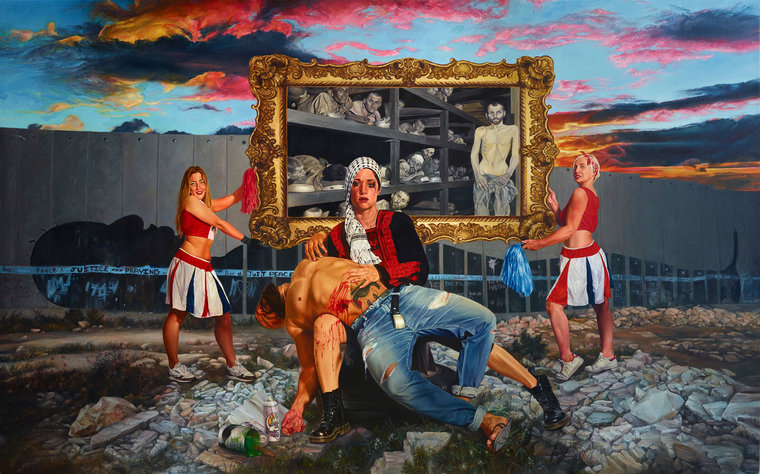Le Pardon, 2017, created by Shadi Alzaqzouq, is a compelling 220x327 cm painting that vividly depicts a theatrical scene. The diagonal positioning of a wounded man in the foreground disrupts the symmetrical composition of the painting. The viewer's attention is captivated by a bullet hole in the young man’s abdomen. The wounded man’s hand falls to the ground, pointing at a spray can. In the forefront, a woman in traditional Palestinian thobe and a Keffiyeh cradles the man’s body, reminiscent of Michelangelo’s iconic La Pieta, 1498-1499.
Le Pardon is a direct commentary on the horrific situation of Palestinians under an apartheid regime. The artist also addresses the oppression of Palestinian artists and the centrality of nonviolent resistance. Comparable to Jesus Christ, the Palestinian martyr lays in the woman’s hands, creating a visual resemblance to Mary and her son in the Madonna della Pieta. The visual comparison speaks to the cyclical nature of history and the recurrence of tragedy on the same land.
Behind this duo, a golden frame unveils a black-and-white photograph depicting the Buchenwald concentration camp during the Holocaust. This unsettling image is held by two Western cheerleaders dressed in the patriotic American flag colors of blue, red, and white. The dual perspective introduces irony and contradiction into the debate by shedding light on the selective practice of Western values and the West’s attempt to wash away its colonial sins with the Zionist state.
The backdrop of the entire tableau juxtaposes the serene beauty of the sunset, with the apartheid wall serving as a literal and visual representation of the term “open-air prison”.
Signed in English front lower right/signed and dated with location in English on reverse




